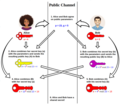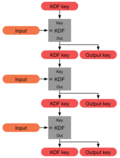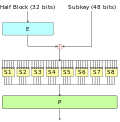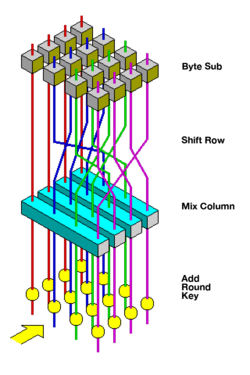cipher key called a round key. A key schedule is an algorithm that calculates all the round keys from the key. Some ciphers have simple key schedules. For...
3 KB (402 words) - 17:31, 15 March 2023
The Advanced Encryption Standard uses a key schedule to expand a short key into a number of separate round keys. The three AES variants have a different...
6 KB (974 words) - 15:48, 26 April 2025
RC4 (redirect from Key-scheduling algorithm)
permutation is initialized with a variable-length key, typically between 40 and 2048 bits, using the key-scheduling algorithm (KSA). Once this has been completed...
44 KB (5,081 words) - 14:07, 26 April 2025
Symmetric-key algorithms are algorithms for cryptography that use the same cryptographic keys for both the encryption of plaintext and the decryption...
15 KB (1,540 words) - 19:12, 22 April 2025
Blowfish (cipher) (redirect from Blowfish key)
of the design include key-dependent S-boxes and a highly complex key schedule. Blowfish has a 64-bit block size and a variable key length from 32 bits up...
18 KB (2,000 words) - 15:11, 16 April 2025
key exchange is a mathematical method of securely generating a symmetric cryptographic key over a public channel and was one of the first public-key protocols...
48 KB (5,437 words) - 16:48, 22 April 2025
function Key distribution center Key escrow Key exchange Key generation Key management Key schedule Key server Key signature (cryptography) Key signing...
13 KB (1,524 words) - 21:51, 14 May 2025
security of IDEA in practice. The very simple key schedule makes IDEA subject to a class of weak keys; some keys containing a large number of 0 bits produce...
12 KB (1,499 words) - 19:07, 14 April 2024
employ a cipher designed to prevent related-key attacks altogether, usually by incorporating a strong key schedule. A newer version of Wi-Fi Protected Access...
5 KB (688 words) - 10:33, 3 January 2025
same encryption function, but differ in the number of rounds and the key schedule. More recent versions – SAFER+ and SAFER++ – were submitted as candidates...
7 KB (853 words) - 13:23, 13 May 2025
to: A hard-coded parameter in a key schedule A key in OpenPGP that is bound by a master key Key (disambiguation) Key (cryptography) This disambiguation...
212 bytes (58 words) - 05:42, 30 December 2019
Serpent (cipher) (section Key schedule)
32-n) uint32_t key[8]; // key provided by user uint32_t subkey[33][4]; // roundkeys const uint8_t S[8][16] = {}; // S-boxes /* key schedule: get prekeys...
16 KB (1,962 words) - 07:47, 17 April 2025
cryptography, a key derivation function (KDF) is a cryptographic algorithm that derives one or more secret keys from a secret value such as a master key, a password...
13 KB (1,640 words) - 18:48, 30 April 2025
Cryptography (section Symmetric-key cryptography)
a "public key" to encrypt a message and a related "private key" to decrypt it. The advantage of asymmetric systems is that the public key can be freely...
99 KB (10,975 words) - 11:30, 14 May 2025
128-bit key. It has a Feistel structure with a suggested 64 rounds, typically implemented in pairs termed cycles. It has an extremely simple key schedule, mixing...
13 KB (1,189 words) - 03:44, 16 March 2025
Data Encryption Standard (section Key schedule)
Figure 3 illustrates the key schedule for encryption—the algorithm which generates the subkeys. Initially, 56 bits of the key are selected from the initial...
60 KB (6,714 words) - 15:08, 11 April 2025
Advanced Encryption Standard (redirect from AES Key)
KeyExpansion – round keys are derived from the cipher key using the AES key schedule. AES requires a separate 128-bit round key block for each round plus...
50 KB (5,675 words) - 00:20, 17 May 2025
In cryptography, key size or key length refers to the number of bits in a key used by a cryptographic algorithm (such as a cipher). Key length defines the...
29 KB (3,222 words) - 03:31, 9 April 2025
The 2024–25 network television schedule for the five major English-language commercial broadcast networks in the United States covers the prime time hours...
142 KB (7,944 words) - 04:20, 18 May 2025
in contrast to key scheduling, which typically refers to the internal handling of keys within the operation of a cipher. Successful key management is critical...
34 KB (3,512 words) - 09:26, 24 March 2025
Block cipher mode of operation (redirect from Key feedback mode)
the same plaintext is encrypted multiple times independently with the same key. Block ciphers may be capable of operating on more than one block size, but...
52 KB (5,828 words) - 22:45, 25 April 2025
For example, in applications where the key is used for a cipher, the key schedule in the cipher may be modified so that it takes a specific length of time...
14 KB (1,816 words) - 19:22, 1 May 2025
similar, even identical in some cases, requiring only a reversal of the key schedule. Therefore, the size of the code or circuitry required to implement such...
10 KB (1,316 words) - 19:41, 2 February 2025
The 2025–26 network television schedule for the five major English-language commercial broadcast networks in the United States will cover the prime time...
58 KB (2,793 words) - 15:27, 17 May 2025
Brute-force attack (redirect from Exhaustive key search)
attempt to guess the key which is typically created from the password using a key derivation function. This is known as an exhaustive key search. This approach...
21 KB (2,246 words) - 04:47, 5 May 2025
A public key infrastructure (PKI) is a set of roles, policies, hardware, software and procedures needed to create, manage, distribute, use, store and...
35 KB (4,119 words) - 04:22, 26 March 2025
not recommended for the NESSIE portfolio because of concerns about its key schedule, while SHACAL-2 was finally selected as one of the 17 NESSIE finalists...
9 KB (903 words) - 07:08, 27 April 2022
RSA cryptosystem (redirect from RSA public key cryptography)
The RSA (Rivest–Shamir–Adleman) cryptosystem is a public-key cryptosystem, one of the oldest widely used for secure data transmission. The initialism...
60 KB (7,787 words) - 23:29, 17 May 2025
key (PSK) is a shared secret which was previously shared between the two parties using some secure channel before it needs to be used. To build a key...
3 KB (416 words) - 16:50, 23 January 2025
messages involves keys. The two main types of keys in cryptographic systems are symmetric-key and public-key (also known as asymmetric-key). Many complex...
34 KB (3,645 words) - 17:52, 2 May 2025















